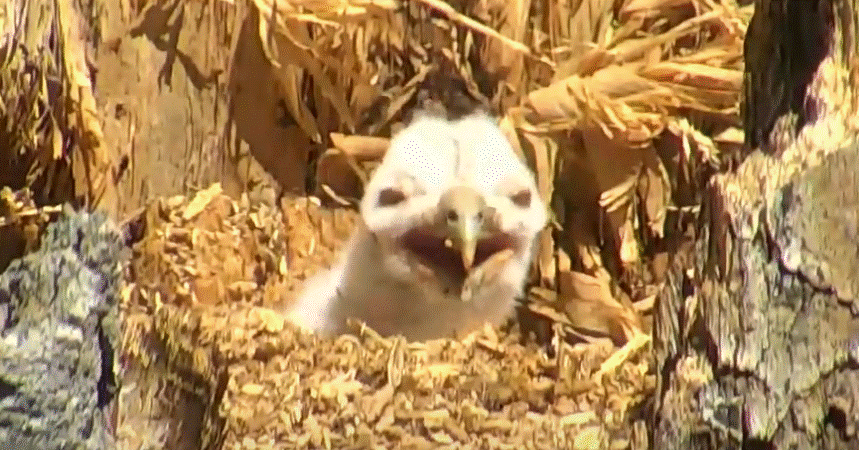Hello Little Ones! Great Gray chicks show their faces in a big way!
It was a very exciting day at the live cam nest yesterday. We were afforded our first, super clear views of the chicks – the perfect picture of new life! They certainly look to be active and strong. Thank you for taking so many incredible snapshots and video to document this special occasion!

Photo thanks to KD J and explore.org.
Right now, these two chicks are approximately nine and seven days old (8 and 6 in the video). Their eyes are half-way open. The second natal down (mesoptile) is visible on the back of the head and will replace the first, bright white, natal down (neoptile) they are covered with at hatching. It’s still possible there is third chick in the nest. We would expect to see movement from a four-day old chick, but this was just a quick peek. And this nest bowl is very deep! While a third chick doesn’t look likely, but we’ve been surprised too many times to rule it out! And, as always, time will tell.
Video thanks to Mairzedotes and explore.org
Many of you commented on their very visible ears. As adults these will be long slits along the facial disk. This ear is typical of Strigidae family owls (which includes all owls except Barn Owls). Owls in the Tytonidae family, which are the oldest known owls and referred to as "Barn Owl types," have roundish ear openings. As the chicks grow, their ears and facial disk will work together to triangulate sound and give them their incredible hearing. As adults, Great Grays can detect prey under 1.5 feet of snow – some believe from over 300 feet away! Hearing like this is akin to a superpower! We don’t have a photo of a Great Gray ear slit, but here is one on a Long-eared Owl, located behind the eye.

Photo thanks to Kurt Lindsay.
After so much excitement in the nest, the forest itself had a moment! A scary one. A tree near the nest fell and landed very close by. Mom flushed, the floor shook, but all was well in the end. Without going to the site, we don’t have any information about how close it was, etc, but – of course – trees routinely fall. In fact, this forest floor has many downed trees. It’s part of what makes it such a perfect place to nest.
Video thanks to Mairzedotes and explore.org.
Standing and fallen, dead trees are important components of forest ecosystems. Once fallen, they return nutrients to the soil, host important bacteria and fungi, create pathways for countless insects, build habitat for small mammals, become drumming platforms for Rough Grouse, and much, much more. For Great Gray chicks who have left the nest, they provide critically important hiding and climbing spots, cover and protection. While we talk a lot about the importance of snags for nesting, fallen trees are super important, too! We are, however, so relieved this falling tree only created a temporary disturbance at the nest!

Photo thanks to Daniel J. Cox
Much like with the harassing raven a couple of days ago, these events remind us of the challenges faced each nesting season. The future of a nest, and all life it holds, is often determined in a split second. It’s also important to remember that nest failures are a natural, and not uncommon, part of Great Gray reproduction.
As many of you know, our Great Gray Nesting Behavior Remote Monitoring Project is well underway. And it’s thanks to you that so much important information is being collected! A great deal is known about many owl species – but not so with Great Grays. Your observations expand what is known about these owls. And it all matters. After all, we can’t help what we don’t understand.
I want to send a huge thank you to all who have been monitoring from the beginning – and welcome all of you who have just come on board! If you are interested in becoming a project volunteer, please click here to visit our Volunteer Resource Page.

Photo thanks to Daniel J. Cox
Our Great Gray Project is in its sixth official year. Comparatively, it is one of our newer projects, but it grows in importance each year. Right now, it's Great Gray Week – a time to celebrate all things Strix nebulosa and generate funds for this special project! Please help continue this work by donating. Every amount helps! Click here to donate and Give for Grays Today!
We'll even send you a sticker to say thanks! :)

Have a Great Gray Day!













